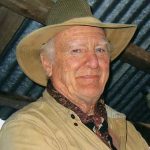
Controversial, colorful, and passionately dedicated to the Bigfoot and Yeti search, Peter Byrne was a pioneer with a robust presence and keen investigative skills, attracting critics and supporters alike.
In the 1950s, his colleagues advocated killing a Bigfoot to prove its existence, but Byrne opposed that. He advocated electronic surveillance to locate the hominid, and taking photos and tissue samples for proof. His goal was to find a Bigfoot and establish communication.
While searching for Yeti in 1959, Byrne was involved with the reputed Yeti artifact from the Pangboche monastery in Nepal. He found his first Yeti footprint in Sikkim in 1948, and launched a three-year project to track it in 1957. Byrne also headed several projects in the Pacific Northwest, including one that incorporated high-tech search tools and an 800 number tip line. He later investigated the Skunk Ape in southern Florida.
Born in Ireland, Byrne lived in India before moving to Oregon. He is one of the Four Horsemen of Sasquatchery.
Author of several books, “The Search for Bigfoot,” a provocative and insightful account of his research work, is widely regarded as one of the best in the field.




